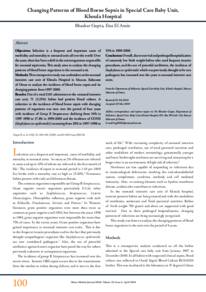وثيقة
Changing patterns of blood borne sepsis in Special Care Baby Unit, Khoula Hospital.
المساهمون
El Amin, Eisa., مؤلف
الناشر
Oman Medical Specialty Board.
ميلادي
2010-04
اللغة
الأنجليزية
الملخص الإنجليزي
Objectives: Infection is a frequent and important cause of morbidity and mortality in neonatal units all over the world. Over the years, there has been a shift in the microorganisms responsible for neonatal septicemia. This study aims to analyze the changing patterns of blood borne organisms in the neonatal unit. Methods: This retrospective study was undertaken at the neonatal intensive care unit of Khoula Hospital in Muscat, Sultanate of Oman to analyze the incidence of blood borne sepsis and its changing pattern from 1997-2000. Results: Out of a total 2181 admissions to the neonatal intensive care unit, 71 (3.25%) babies had positive blood culture. A reduction in the incidence of blood borne sepsis with changing patterns of organisms was seen over the period of four years with incidence of Group B Streptococcus declining from 34% in 1997-1998 to 17.8% in 1999-2000 and the incidence of CONS (Staphylococcus epidermidis) increasing from 20% in 1997-1998 to 35% in 1999-2000. Conclusion: Overall, due to survival and prolonged hospitalization of extremely low birth weight babies who need frequent invasive procedures, and the use of powerful antibiotics, the incidence of Staphylococcus epidermidis which was previously thought to be non pathogenic has increased over the years in neonatal intensive care units.
المجموعة
URL المصدر
قالب العنصر
مقالات الدوريات

